

Catch Fish with
Mike Ladle
Information Page
Freshwater Fishing
For anyone unfamiliar with the site always check the FRESHWATER, SALTWATER and TACK-TICS pages. The Saltwater page now extends back as a record of over several years of (mostly) sea fishing and may be a useful guide as to when to fish. The Freshwater stuff is also up to date now. I keep adding to both. These pages are effectively my diary and the latest will usually be about fishing in the previous day or two. As you see I also add the odd piece from my friends and correspondents if I've not been doing much. The Tactics pages which are chiefly 'how I do it' plus a bit of science are also updated regularly and (I think) worth a read (the earlier ones are mostly tackle and 'how to do it' stuff).
Variety on small plugs.
My local rivers, like many others, are extremely low at the moment. The warm, dry weather has reduced flows everywhere and even the chalk streams, fed by mainly ground water, are looking distinctly thin. Along with the reduced volume, the water is extremely clear, the deeper stretches are very slow flowing and the faster flowing bits are so shallow that they can be tricky to fish.
I enjoy most branches of the sport but since the sea-shore fishing has recently often been on the slow side; despite the low flows, I've turned my attention to river fish. One of the most consistent catches has been seatrout. Even in the warm weather if I fish either side of dusk there is a good chance of one or two takes. It is interesting to explore each stretch of river in order to find out where (if anywhere) the trout are biting. The banks where I fish are mostly heavily overgrown with nettles, Himalayan balsam and scrubby willow trees - not ideal for fly casting in the gloom, so the best approach to searching in the dark is by lure fishing. Seatrout are generally keen to eat small fish - somewhere between the size of a big minnow and a salmon smolt, roughly five to fifteen centimetres in length. In the stretches that I fish the lure doesn't need to be cast too far and it has to 'work' in all combinations of flow and depth so ideally, it must not sink to the bottom in the shallows nor fail to operate in still water. The best and most effective choice that I've found for this purpose is a jointed Rapala.
I generally start fishing while I can still see the opposite side of the channel, this gives me time to get a 'feel' for the distance I must cast to avoid far-bank hang ups. It soon becomes second nature to time the flight of the plug to avoid overcasting and, if I'm in any doubt, I simply pitch it down mid-channel. The best feature of the little balsa plugs is that it is easily possible to 'feel' the vibration as they wriggle along and, conversely, if they pick up even the smallest piece of debris or plant material it is instantly apparent that they've 'stopped working'. It is rarely worth more than two or three casts from any position and a missed bite or lost fish usually means that it's time to move on to the next stance. The same tactic has proved to be pretty effective for a variety of predators.
The evening sessions described were short (an hour-and-a-half at most) and only the afternoon one lasted longer. The first one was my usual dusk sortie. I only landed a single seatrout but before catching it I missed two takes including one very large fish which rushed out from the far bank pushing up a huge bow-wave, took, jumped and came off - an event greeted with the usual string of "Dear me, what a shame" type comments.
The late seatrout - pity I missed the larger fish!
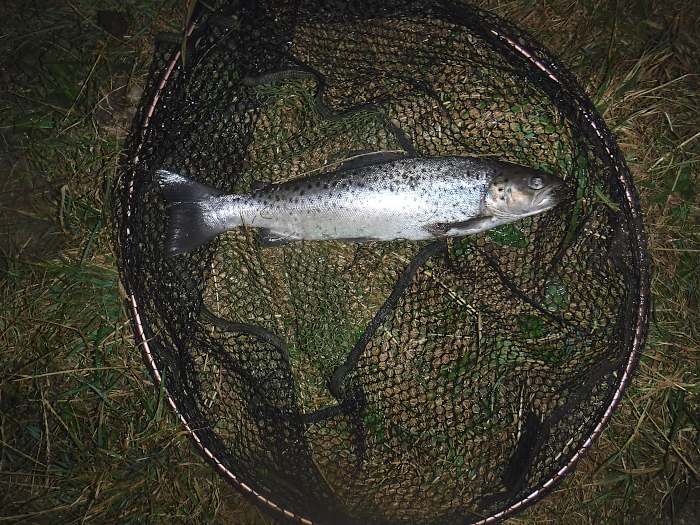
The following day my wife was working so, being free to fish during the day, I decided to try plugging a different stretch of river - wider and wadeable. I had opted for a slightly larger (9cm) Rapala which doesn't dive quite so deep as my normal 'seatrout-lure'. I started by walking out onto the concrete apron of a weir which crossed the river. After a few abortive casts I paddled across (ankle deep) flicking the little plug into various runs downstream of the weir. Nothing happened until I reached a position where I could cast back along the sill. The lure dropped right into the little curtain of water pouring over the lip and was instantly grabbed by a powerful fish which thrashed strongly, took a metre or two of line and jumped clear of the water as it threw the lure. Another good sized (2-3kg) trout lost - buns! I pressed on downstream and had one more bite which produced a lesser trout that I unhooked and returned.
The trout taken on my larger lure.
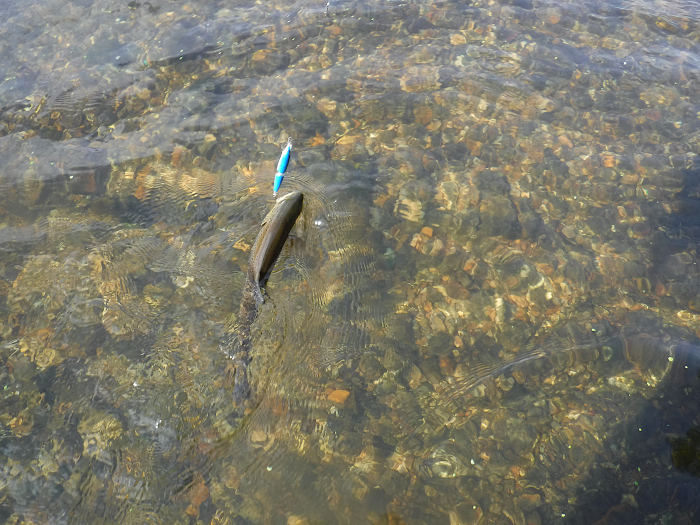
A closer look at the trout on the blue and silver, 9cm plug.
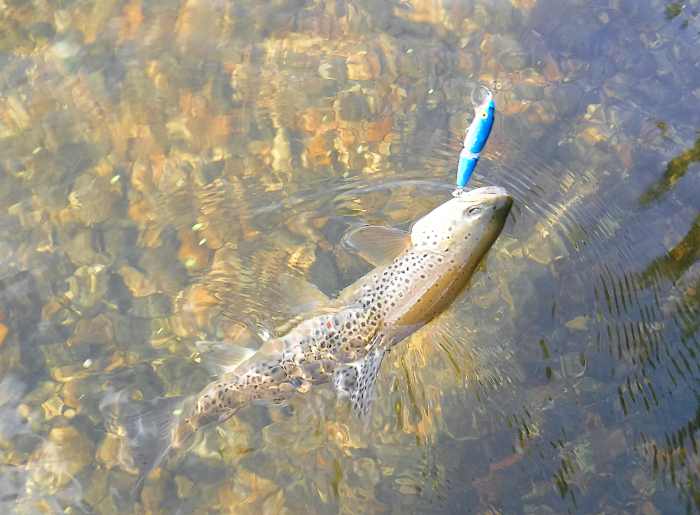
Now I continued down, walking along the high bank, often a metre or more above the water. Most stretches were too shallow and weedy to be fishable even with the, rather too buoyant plug. After about twenty minutes I had a follow from a couple of large chub which were tucked into a pool behind an alder bush on the near bank. The fish linspected the plug but didn't take, after a minute or so they melted away into the weeds. I continued on until I came to a shallow, gravel bedded stretch; the water was, at most, thirty centimetres deep and rushing along. I changed lures to my 7cm Rapala. First cast there was a take and I reeled in a small chub. The next few casts into the fast water produced four more bites, two missed and two additional chub bigger than the first. Good fun.
After reaching the downstream limit of the section I switched lures again, this time to a Mepps, and worked my way back up. It was difficult to fish effectively with the metal spinner and apart from an attack by a pike (which missed the lure) I had nothing. Eventually I reached the riffle which had produced the three chub and switched back to my Rapala. First cast resulted in another small chub. Now it was time to return home and make the tea - a pleasant afternoon.
The first chub.
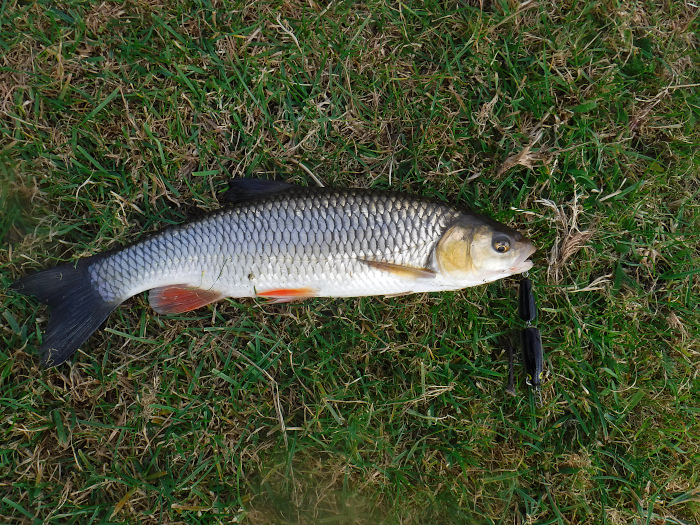
The mouth of even a small chub is large enough to cope with these little plugs.
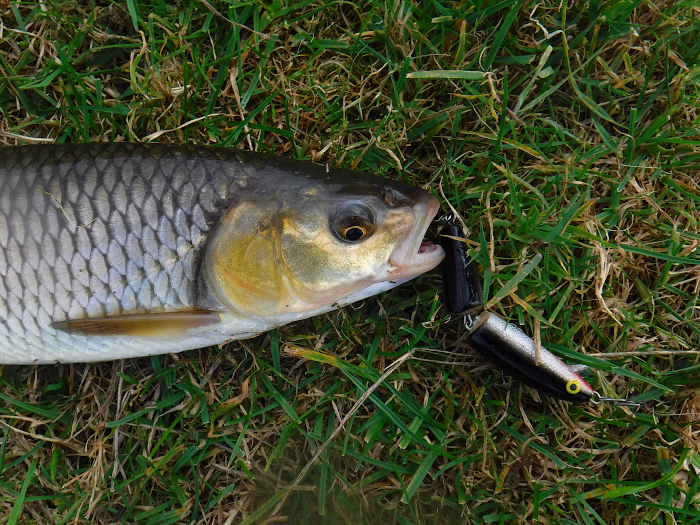
A bigger, fatter chub on the same lure.
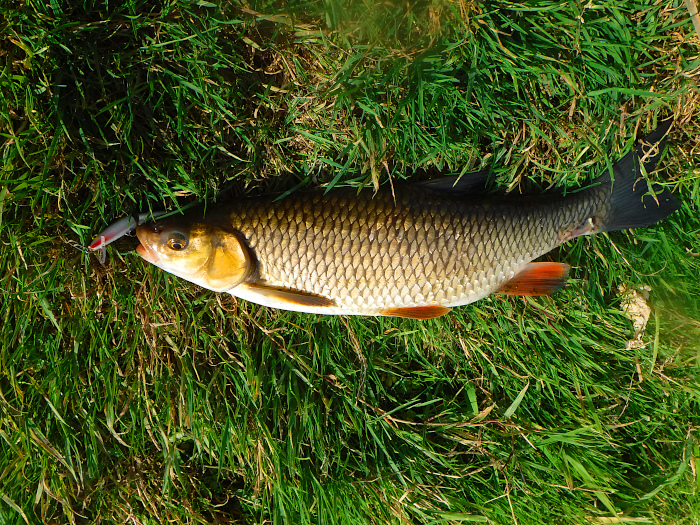
...and another, modest chub on the small lure.
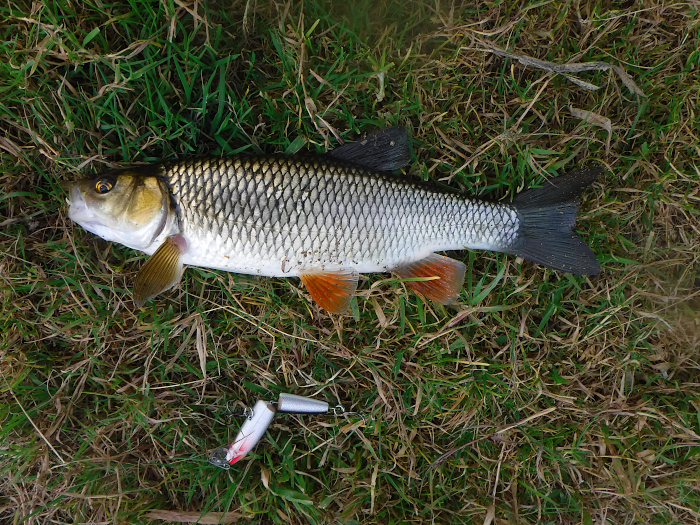
The fourth chub slid ashore onto some slimy, green algae.
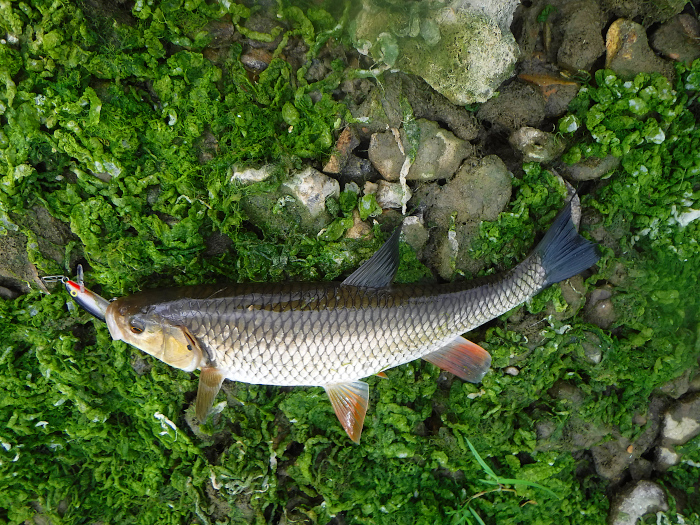
The following day I decided to have an hour after seatrout as darkness fell. I adopted the usual strategy of working my way downstream fishing the small Rapala down and across. I started while it was still relatively light and it was about fifteen minutes before I had a bite - a tentative tap and a small, bow wave. following behind the lure. Worth another cast I thought. Out went the plug again and as it swung across the current there was a firm pull and a big splash. My hopes were raised but after another minute of play with no sign of the fish I began to think that it was probably a pike. Sure enough when I eventually brought it close enough to see, it was exactly what I expected and, after it had dived into some overhanging reeds it had to be untangled before I could net it. After returning the pike I fished on until darkness fell and was just about to pack in when the lure was taken, almost as it hit the water, in a fast, shallow run. This time the surface activity showed that it was undoubtedly a nice seatrout which I slid ashore, took a picture and returned to the river before walking back to the car.
Just as well I always use the wire trace - the pike had engulfed the lure but was just hooked inside its lips.
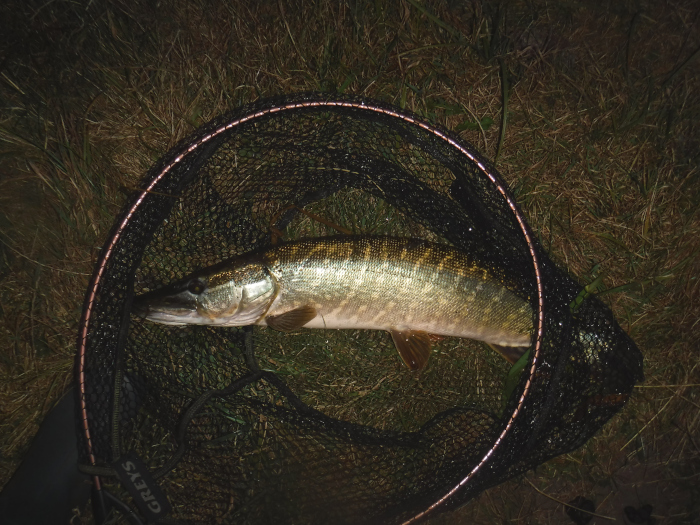
The final seatrout from fast-flowing, shallow water.
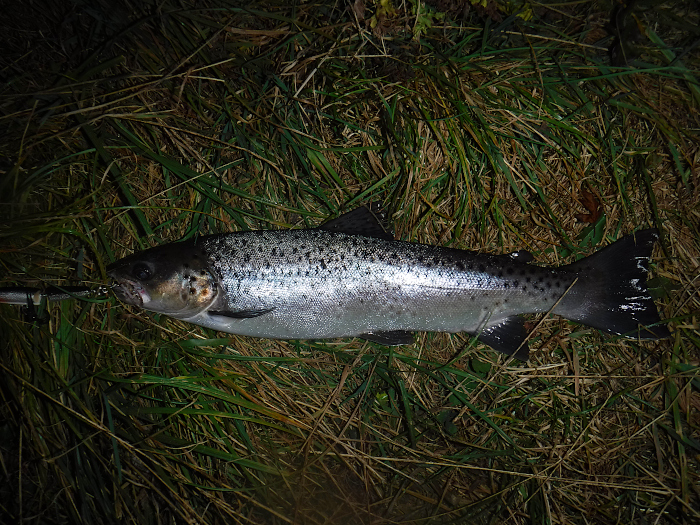
If you have any comments or questions about fish, methods, tactics or 'what have you!' get in touch with me by sending an E-MAIL to - docladle@hotmail.com